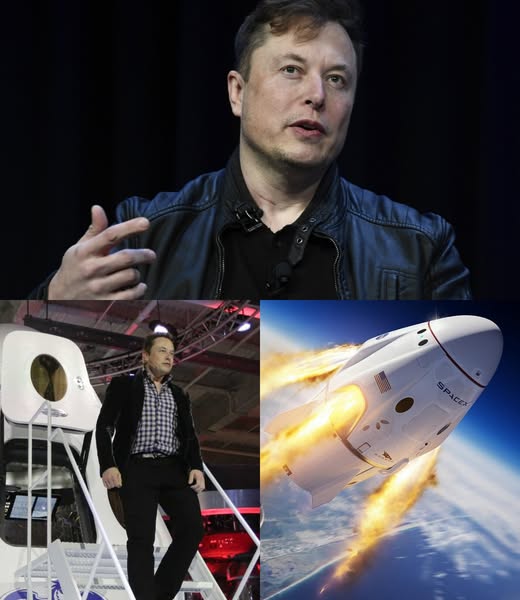On June 5, 2025, the space community was rocked by an announcement that reverberated far beyond the launch pads of Cape Canaveral. Elon Musk, CEO of SpaceX, declared that his company would begin decommissioning the Dragon spacecraft, a cornerstone of American spaceflight since its crewed debut in 2020. The abrupt announcement came on the heels of a threat by former President Donald Trump to cancel up to $22 billion in federal contracts tied to SpaceX and other Musk-led ventures.
While the situation evolved rapidly, with Musk walking back his statement just hours later, the moment exposed a simmering tension between business, politics, and national space strategy. It posed a profound question: how fragile is the modern U.S. space ecosystem when personality clashes and political maneuvers take center stage?

The Dragon and Its Legacy
To understand the weight of Musk’s announcement, one must appreciate the significance of the Dragon spacecraft. Originally designed for cargo delivery to the International Space Station (ISS), the Crew Dragon variant became the first U.S. capsule to carry astronauts to orbit since the retirement of the Space Shuttle in 2011. Its success symbolized a triumphant shift toward public-private partnerships, allowing NASA to lean on private enterprise while focusing on deep space exploration.
Dragon’s reliability—launching astronauts for NASA, private missions for Axiom Space, and cargo runs to the ISS—made it a linchpin of low-Earth orbit operations. It was not just a spacecraft; it was America’s space taxi, bridging the technological and logistical gap during a time of transition and geopolitical tension.
Trump’s $22 Billion Ultimatum
On June 4, 2025, Donald Trump, once again a dominant political figure with aspirations of returning to the White House, issued a pointed statement targeting Elon Musk. Citing concerns about “excessive federal spending on unreliable tech billionaires,” Trump threatened to cancel $22 billion worth of government contracts tied to SpaceX, Starlink, and Tesla’s energy projects.
The motivation, though partially framed in fiscal responsibility, seemed more personal. Musk had recently made public comments critical of Trump’s stance on immigration, climate change, and digital censorship. In response, Trump’s team framed Musk as “un-American” and too cozy with globalist interests—an echo of earlier rhetoric used against tech leaders.
The threat was not idle. A Trump administration could exert significant pressure on NASA, the Pentagon, and other federal entities to redirect funds toward legacy contractors like Boeing, Lockheed Martin, and Northrop Grumman—firms with deeper roots in traditional defense networks and more predictable political alliances.
Musk’s Response: A Shot Across the Bow
Within 24 hours of Trump’s threat, Elon Musk responded with a tweet that would send shockwaves across the aerospace industry:
“Effective immediately, SpaceX will begin retiring the Dragon spacecraft. If the U.S. government doesn’t want our services, we won’t provide them. Godspeed.”
—@elonmusk, 10:38 AM, June 5, 2025
This wasn’t just tech drama—it was a potential existential blow to America’s space ambitions. NASA had Dragon missions planned through 2028. Axiom Mission 4, a high-profile commercial flight to the ISS, was scheduled to launch within days. The Pentagon had just signed a logistics payload contract for the same platform.
Musk’s tweet seemed to signal a retreat from government collaboration, a return to SpaceX’s roots as a fully private entity. But the timing—so close to a scheduled crewed launch—raised alarm bells within NASA, the White House, and Congress.
Rapid Reversal and Public Outcry
By the evening of June 5, public pressure mounted. Hashtags like #SaveSpaceX, #KeepFlyingDragon, and #MuskVsTrump trended worldwide. Astronauts, scientists, and even rival space company executives urged restraint and dialogue. Axiom Space CEO Michael Suffredini issued a statement warning of “cascading consequences” if Dragon were suddenly decommissioned.
Just before midnight, Musk tweeted again:
“Let’s de-escalate. I’m with Team America. Dragon continues—for now.”
—@elonmusk, 11:48 PM, June 5, 2025
The immediate crisis had been averted. But the underlying damage—trust, operational certainty, and policy alignment—remained fractured.
The Bigger Picture: Political Volatility in Space
This incident was more than a media flashpoint. It was a stark reminder of the risks in politicizing space exploration.
Since the early 2000s, the U.S. has increasingly turned to commercial partnerships to execute space missions, from launching satellites to building lunar landers. SpaceX’s success helped validate this model. But when government contracts account for billions in revenue—and when executives like Musk are also vocal political figures—the line between policy and politics blurs dangerously.
Critics argued that Trump’s threat undermined America’s strategic edge in space. Allies like Japan, Canada, and the European Space Agency rely on Dragon to access the ISS. Any disruption could weaken multinational cooperation and embolden rival powers like China, which continues to expand its Tiangong space station and Mars mission plans.
Others pointed to the danger of Musk’s impulsiveness. If a single tweet could derail missions involving international astronauts and national defense, perhaps deeper governance mechanisms were needed. NASA insiders revealed that emergency meetings had been held to discuss alternative crew transport options—including reliance on Russia’s Soyuz or accelerating Boeing’s troubled Starliner program.
Economic Fallout and Market Reaction
The stock market didn’t take kindly to the drama. Tesla shares dipped 4% the day after the announcement. SpaceX, still privately held, faced questions from investors about contract stability. Defense analysts worried about national security payloads dependent on Falcon 9 and Falcon Heavy launches—also operated by SpaceX.
Meanwhile, Trump’s declaration to “rethink public-private partnerships in space” was met with skepticism from defense insiders who know that no other provider has matched SpaceX’s scale, cost efficiency, or launch cadence. Ending the relationship might feel politically satisfying, but it could cripple U.S. space operations for years.
Is the Partnership Model at Risk?
The deeper concern is whether this episode marks the beginning of a receding tide for public-private partnerships in U.S. space exploration. While NASA has long championed collaboration—with programs like Commercial Crew, Artemis HLS (Human Landing System), and CLPS (Commercial Lunar Payload Services)—the political cost may be rising.
Space policy experts warn of an impending “re-nationalization” push, where government control is reasserted over missions currently executed by companies like SpaceX, Blue Origin, and Sierra Space. Trump’s rhetoric, while targeted at Musk, may extend to the entire commercial sector, forcing companies to prove their loyalty not just to mission objectives but to partisan agendas.
Musk’s ideological independence—sometimes libertarian, sometimes technocratic—makes him a unique figure in the space community. But in a future where government contracts represent not just economic lifelines but litmus tests of allegiance, his position may become increasingly precarious.
What’s Next?
As of now, Dragon is still scheduled to fly. Axiom Mission 4 will proceed. NASA has not commented officially beyond a brief statement reaffirming its commitment to “safe, reliable, and collaborative access to space.”
But changes are coming. Congressional hearings are likely. The House Committee on Science, Space, and Technology is expected to question NASA officials and SpaceX executives about the incident. The Pentagon may reassess how heavily it leans on Musk for satellite launches. And foreign space agencies are undoubtedly watching closely, worried about the domestic volatility of the U.S. space program.
SpaceX, for its part, will likely refocus on Starship—a fully reusable vehicle designed for lunar and Mars missions. Unlike Dragon, Starship has more potential to operate independently of NASA or DOD contracts. It represents Musk’s long-term vision of human colonization of other planets—a goal far beyond political cycles and contract disputes.
Still, the Dragon debacle will leave a mark. It exposed the fragile balance between innovation and ideology, private ambition and public responsibility.
Conclusion: A Warning from the Edge of Space
In the end, the near-cancellation of the Dragon program may be remembered not as a technical failure or political stunt, but as a cautionary tale. When space becomes another battleground for political theater, everyone—scientists, astronauts, taxpayers, and humanity’s future among the stars—stands to lose.
The Dragon will fly again. But the system that supports it may need a full systems check.


